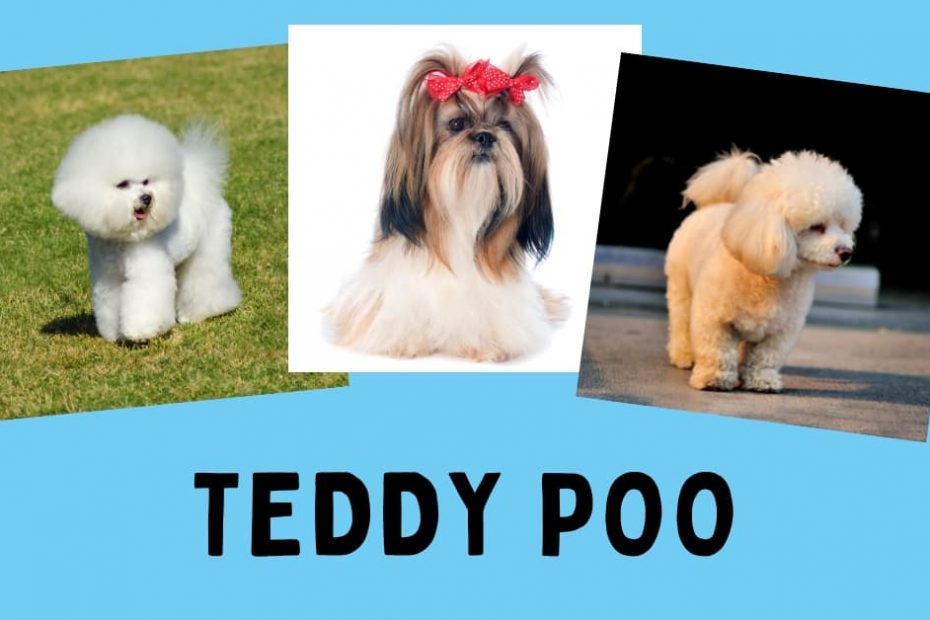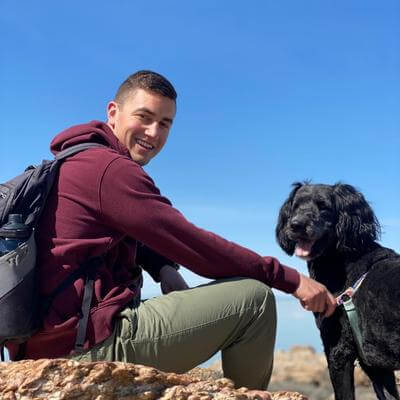Are you tired of the same old dog breeds? Well, you should meet the Teddy Poo: the ultimate combination of cuddly teddy bear and smart pooch!
These pups will melt your heart with their fluffy coats and adorable faces. But don’t be fooled by their cute exterior – Teddy Poos are also highly intelligent and can be trained to do all sorts of tricks.
Trust me, you won’t be able to resist the charms of a Teddy Poo. So go ahead and learn more about these lovable mutts – your life (and Instagram feed) will thank you.
What is a Teddy Poo?
The Teddy Poo is a small-sized Doodle breed that mixes three other popular and well-established breeds: Shih Tzu, Bichon Frise, and Toy Poodle. The name Teddy Poo was given to the breed because it resembles an adorable Teddy Bear. The mix can also be called a Shichonpoo.
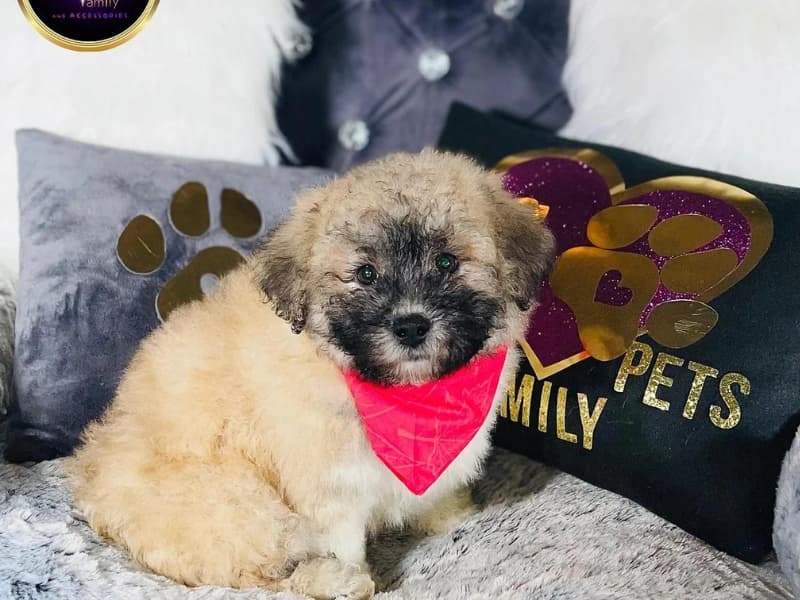
Before we get into how these dogs make a Teddy Poo, let’s review some common mixes of the Teddy Poo’s parent breeds.
A good starting point is with the Shih Tzu and the Bichon Frise. Together, they make a Zuchon or Shichon.
Next, a Bichon Frise crossed with a Poodle creates a Poochon or Bichpoo.
Finally, a Poodle and Shih Tzu make a Shihpoo.
Teddy Poos, also known as Shichonpoos, fall under that classification if they are:
- A Zuchon mixed with a Toy Poodle, or
- A Poochon mixed with a Shih Tzu, or
- A Shihpoo mixed with a Bichon Frise.
To better understand Teddy Poos, let’s take a closer look at each of their parent breeds.
History of the Parent Breeds
Teddy Poos come from some fascinating origins. We will go over where the inspiration for these dogs derived from and how their ancestors came to be.
Shih Tzu
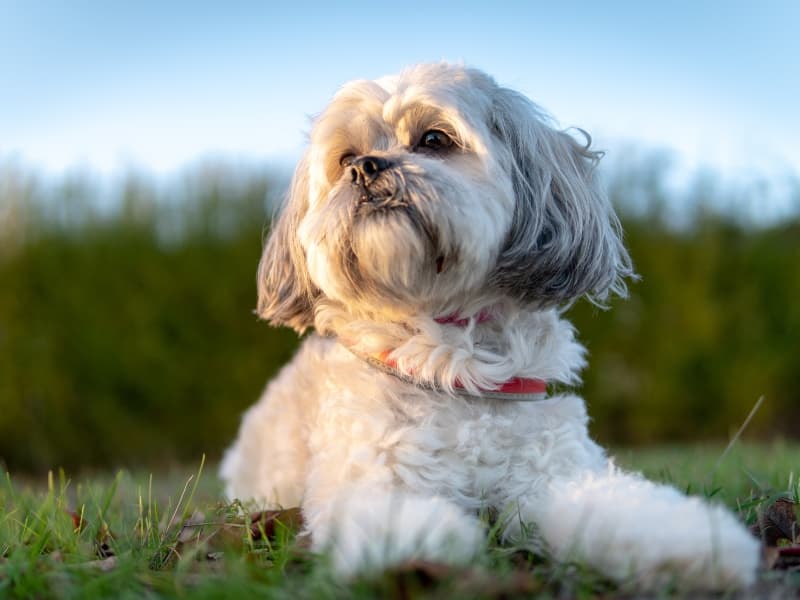
This small, fluffy lap dog has been part of the western world since they were first imported to England almost a century ago. Coming from Tibet, it’s believed they came into being after a match between a Pekingese and a Lhasa Apso.
It didn’t take long for this breed to become popular in the states. By the 60s, there were multiple clubs dedicated to the Shih Tzu.
Bichon Frise
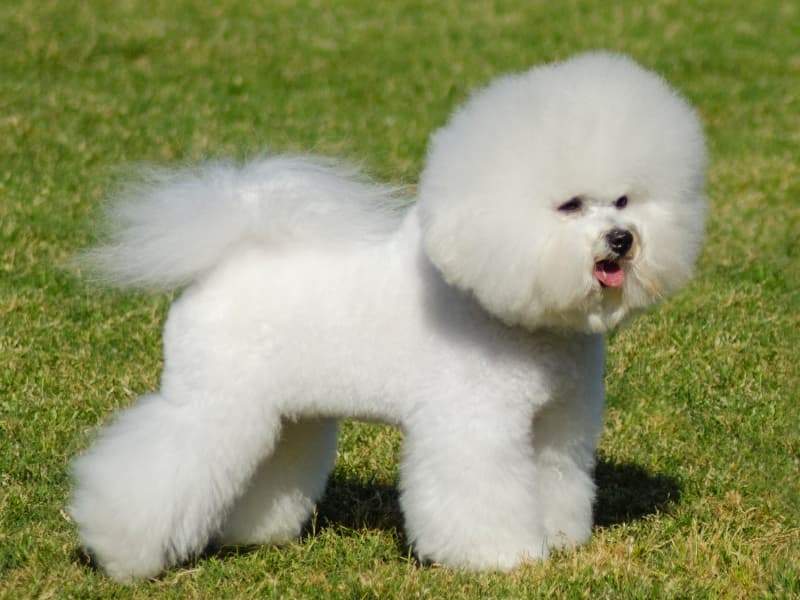
Not every day, you come across a dog that ancient Egyptians may have worshiped. Bichon Frise comes from a line of dogs widely considered the world’s oldest breed.
These little fluffs have been written about in hieroglyphics by the famed philosopher Aristotle, who compared them to clouds. Born on the island of Malta, Bichon’s ancestors were working dogs. While hunting may be part of the heritage, it didn’t influence the breed’s current state.
Poodle
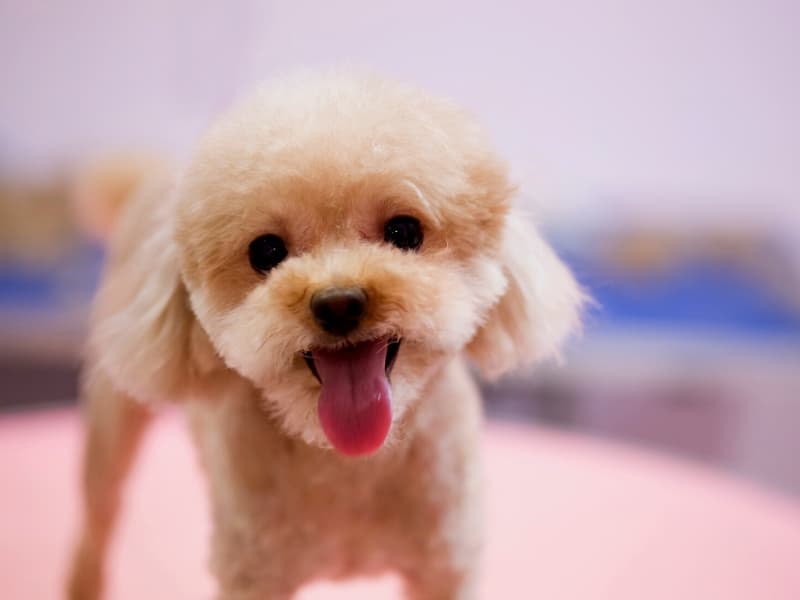
The Poodle originated in Germany sometime in the 17th century. The breed was established as waterfowl hunters. They aided hunters in the retrieval of downed game in the frigid waters of Europe.
Due to their adorable looks, intelligence, and athleticism, the Poodle eventually became popular throughout Europe. As more people adopted Poodles as companions rather than hunting dogs, the breed began to change.
The Standard Poodle was bred down in size to create the Miniature Poodle. Poodle owners sought after a smaller size of the breed since they were easier to travel with and maintain.
Poodles made their way across the Atlantic Ocean to America. The Miniature Poodle was selectively bred down in size to create the Toy Poodle, a perfect dog for those living in cramped urban environments.
Today, the Poodle has three recognized sizes: standard, miniature, and toy. The temperament and traits of the breed are consistent across all three.
Appearance
The parent breeds have a few visual elements in common. First of all, they are thick with fur and often lean towards all-white or primarily white coats. For Teddy Poos, the apple doesn’t fall far from the tree. Between the coats and colors, you can see a family resemblance.
Coat Type
Teddy Poos have two layers to their fur. Each part of the double coat serves its purpose. The undercoat is soft and helps insulate the dog. The topcoat is where the color and texture of the hair really shine.
Shichonpoos have curlier hair on the body and head but straighter hair on the tail, which can be made to look like a pom-pom. Regular grooming is essential with a Teddy Poo to avoid matting, especially if the hair is on the longer side by choice.
Coat Colors
The colors you should expect to find on a Teddy Poo are black, white, brown, and apricot. Of course, these colors are usually not solo acts. More often than not, you’ll see color combinations of white with one of the other choices.
Many Teddy Poos are thought to be white with big patches of color on the body, head, and tail. Less common coat colors are brindle, sable, blue, red, and cream.
Size
As you might have gathered, a Teddy Poo is a lap dog. They may not be small enough to put in a purse and carry around, but these dogs are relatively easy to pick up or transport.
Each parent is small enough to keep in apartments since they don’t require much room. As companions, that makes them great for a broader range of owners.
Height
The average height for all three parent breeds is the same for male and female dogs. The only difference is with the Bichon Frise, where the male is about one inch taller.
With that being said, a Teddy Poo will grow up to be between 8 and 12 inches at the withers. That expectation extends to both sexes.
Weight
While they are all around the same height, the weight fluctuates more. Here’s the weight breakdown for the parent breeds:
- Bichon Frise: males are 14 pounds, females are 10 pounds
- Shih Tzu: both males are females fluctuate between 9 and 16 pounds
- Toy Poodle: both males and females are 6 to 10 pounds.
Teddy Poos weigh between 9 and 13 pounds, with males often falling on the higher end of the scale.
Traits & Characteristics

What is a Teddy Poo like?
So, what’s it like to spend time or live with a Teddy Poo? Quite playful, actually. Not only do they have lots of energy, but they bask in any attention they can get. That also means they are naturally social and friendly with other dogs.
It’s unlikely to see a Teddy Poo chasing down another dog, especially not a big one. That may be different for other animals, like cats.
It would not be surprising to see a Shichonpoo chasing a cat or squirrel, but that’s where the fun ends. They won’t be biting, attacking, or attempting to hurt anyone.
Generally speaking, getting a Teddy Poo as a puppy is a great opportunity. They are intelligent dogs who are trainable if you have the patience and time to dedicate. That will come in handy with barking.
Teddy Poos, and their parent breeds, are prone to be ever alert to outsiders. With proper encouragement, these dogs can be taught to relax a little.
When it comes to families, these wiggly balls of fur are great for older children and up. Teddy Poos might be a tad high-strung for babies and toddlers, especially as a puppy. However, a senior Shichonpoo would likely have more maturity to handle tiny hands.
As Teddy Poos get older, they will be less active and prefer a leisurely existence. This is definitely the type of dog you want if you enjoy having a needier, easygoing companion.
It is possible to dress up a Teddy Poo. The dog may not love it, but they are pretty flexible in terms of things they will put up with.
Their favorite place, though, is by your side. That fact also makes them great for seniors in need of companions.
Common Health Issues
When examining problems with the parent breeds, it seems most likely that the issues Teddy Poos will have the most trouble with are:
- Cataracts
- Progress Retinal Atrophy
- Hip Dysplasia
- Hormone Irregularity
- Patellar Luxation
Other issues that could come up in a Teddy Poo but aren’t necessarily found in all three breeds are:
- Dental disease
- Ear infections
- Kidney stones
- Liver failure
- Breathing issues
- Heart conditions
- Bloat
The best way to keep your Teddy Poo healthy is to have regular checkups with your vet.
Lifespan
Each of the three parent breeds of the Teddy Poo has a similar lifespan. On average, Teddy Poos are expected to live between 10 and 16 years.
Finding a Breeder
If, after everything you’ve read, this sounds like the dog breed for you, it’s time to start a search. Unfortunately, there are some terrible breeders out there to be aware of.
Before you go anywhere, make a phone call to animal shelters within a drivable distance from you. They get purebreds more often than you think.
To find a reputable breeder, the best place to start is with people you know. Try joining local clubs or even online communities for Teddy Poos. Asking for referrals is a great way to find someone that you know someone has experience with.
Another creative way to find someone with Teddy Poos is to attend a dog show. These are the top-of-the-line breeders that have been vetted.
Final Thoughts
When it comes to getting a dog that is quick to learn and fun to have, a Teddy Poo might be the perfect fit.
So, is the Teddy Poo the right pup for you?
Further Reading
If you like the Shichonpoo, you’ll love these small-sized Doodle breeds. Check them out!

